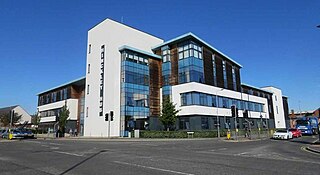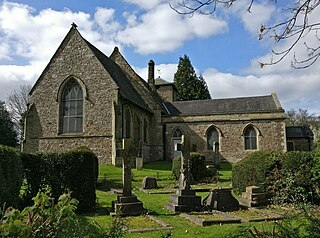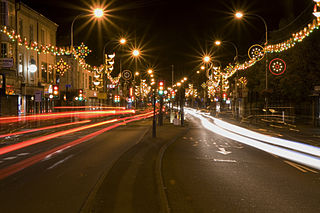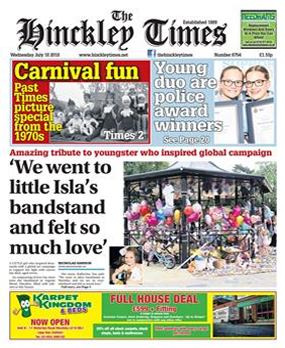
Leicester is a city, unitary authority area, unparished area and the county town of Leicestershire in the East Midlands of England. It is the largest city in the East Midlands with a population of 373,399 in 2022. The greater Leicester urban area had a population of 559,017 in 2021, making it the 11th most populous in England, and the 13th most populous in the United Kingdom. A 2023 report ranked Leicester 16th out of the 50 largest UK cities on a range of economic measures, and the first of seven East Midlands cities.

Blaby is a local government district in Leicestershire, England. The district is named after the village of Blaby, although the council is based in Narborough. The district covers an area lying south-west of the city of Leicester. Several of the district's settlements form part of the wider Leicester Urban Area, including Glenfield, where Leicestershire County Council has its headquarters at County Hall, and the town of Braunstone.

Hinckley is a market town in south-west Leicestershire, England. It is administered by Hinckley and Bosworth Borough Council. Hinckley is the third largest settlement in Leicestershire, after Leicester and Loughborough. Hinckley is about halfway between Leicester and Coventry and borders Nuneaton in Warwickshire. Watling Street forms part of the Leicestershire/Warwickshire border. The town forms an urban area with the village of Burbage, directly to the south.

Leicester Forest East (LFE) is a large suburban village in Leicestershire, England, west of Leicester, straddling the M1 motorway. It is part of the Blaby district.

Narborough is a large village and civil parish in the Blaby district of Leicestershire, England, around six miles southwest of Leicester. The population of the civil parish at the 2011 census was 8,498.

Leicester West is a constituency in Leicestershire. The seat was created in 1974, and existed in a previous form from 1918 to 1950. The seat has been represented in the House of Commons of the Parliament of the United Kingdom by Liz Kendall of the Labour Party since 2010. Kendall currently serves as Secretary of State for Work and Pensions under the government of Keir Starmer. Since its creation in 1918, the seat has sided with parties from the left wing of politics.

Leicester City Centre is Leicester's historical commercial, cultural and transport hub and is home to its central business district. Its inner core is roughly delineated by the A594, Leicester's inner ring road, although the various central campuses of the University of Leicester, De Montfort University and Leicester College are adjacent to the inner ring road and could be considered to be a continuation of the City centre. In a similar way, the Leicester Royal Infirmary precinct, New Walk business district (Southfields), the Welford Road Stadium of Leicester Tigers’ RUFC and the King Power Stadium of Leicester City to the south, and the Golden Mile to the north could also be deemed to be extensions to the central core.

Braunstone is a town and civil parish in the district of Blaby in Leicestershire, England. At the 2011 census the population of the town was 16,850.

Enderby is a village and civil parish in Leicestershire, England, on the southwest outskirts of the city of Leicester. The parish includes the neighbourhood of St John's, which is east of the village separated from it by the M1 motorway. The 2011 Census recorded the parish's population as 6,314.

The Golden Mile is a name given to Belgrave Road, just north east of the city centre in Leicester, England. It is part of the ancient Roman Fosse Way and today is famed for its Indian restaurants, sari shops, jewellers, annual winter illuminations, and its internationally renowned annual Diwali celebrations, the largest of their kind outside of India.

Thorpe Astley is a suburban settlement on the southwestern edge of the city of Leicester, England. It is part of the civil parish of Braunstone Town, although a small part of the development, around Goodheart Way, extends into Leicester Forest East civil parish. Both Braunstone Town and Leicester Forest East are within the district of Blaby, Leicestershire.
Westcotes, also known as West End, is an inner city area of Leicester, England, UK and an electoral ward of Leicester City Council. It is located just west of the city centre over the River Soar and south of West Bridge and the old town West Gates. It’s neighbouring districts are Braunstone to the south, and Dane Hills to the west. The main roads in the area are Braunstone Gate, Hinckley Road and Narborough Road. The proximity to De Montfort University makes it a popular student area. The area is quite small in comparison with other areas of the city, but it is well known for its many shops, bars and restaurants and is a popular choice for students and young professionals.
The Domesday manor of Bromkinsthorpe was situated outside the West Gate of Leicester, on the alluvial west bank of the River Soar. Its location is now covered by the area around Braunstone Gate, Leicester, and for much of the medieval period was a liberty within the parish of St Mary de Castro, Leicester, and hence, part of the Borough of Leicester.

Braunstone Park & Rowley Fields is an electoral ward and administrative division of the city of Leicester, England. It comprises the western Leicester suburbs of Braunstone Frith, Braunstone Park and Rowley Fields.

Aylestone Meadows is an 8.8-hectare (22-acre) Local Nature Reserve in Leicester, England, United Kingdom. It is owned and managed by Leicester City Council.
The following is a timeline of the history of the city of Leicester, the county town of Leicestershire, in England.

The Hinckley Times is a weekly paid-for tabloid newspaper which is distributed every Wednesday and mainly serves the area of Hinckley. The paper further serves the surrounding areas in Leicestershire, including Market Bosworth, Coalville and Lutterworth.
















